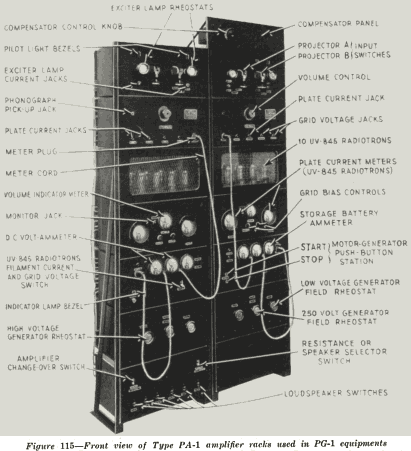The name plates on the jacks indicate the circuit to which the jack is connected, and whether the reading
on the meter is a voltage reading or a current reading, and a multiplying factor by which the meter reading
must be multiplied to obtain volts or milliamperes. For example, consider the jack with the name plate
designation of EB123X100. E stands for "voltage," B stands for "B" or plate supply, 123 means
tubes 1, 2, and 3, the X means multiply the meter reading by, and the 100 is the multiplying
factor. All EBs are plate voltages. All ECs are grid or "C" bias voltages. All IN are plate
currents, as I stands for current. (The multiplying factors for plate current readings are for
giving values of current in milliamperes.)

The meter on the right is for indicating the storage battery current. The zero position is at mid
scale, so that the meter indicates the amount of battery current, and whether the battery is
being charged or discharged. The switch below this meter is a double-pole switch. The two
sides of the switch are in separate circuits, but operate simultaneously. One side is in the
filament circuits of the voltage and power amplifiers. The other side of the switch is in the grid
bias circuit of the power
amplifier and in the field circuit of the 1000-volt generator. Therefore, when this switch is in the "OFF"
position, there will be no current through the filaments of the tubes or exciter lamps, and the grid and
plate voltages of the power amplifier, and the plate voltage of the voltage amplifier will be reduced to a
very low value. This switch can be used to stop the operation of the rack equipment without stopping
the motor-generator set, or to charge the storage battery when the amplifier is not in use. To charge the
storage battery when not using the amplifier, with the motor-generator set "on", turn the switch to the
"OFF" position and regulate the charging rate, as indicated on the storage battery ammeter, by means of
the 15-volt generator field control.
4
